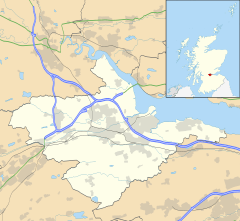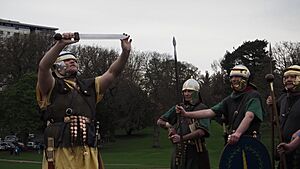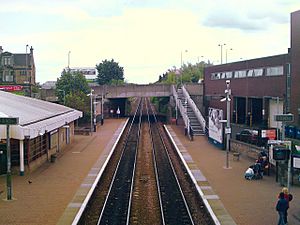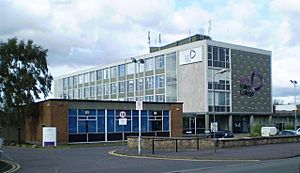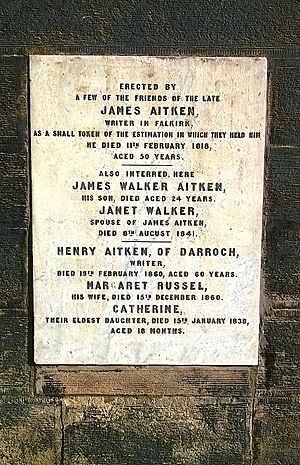Falkirk facts for kids
Quick facts for kids Falkirk
|
|
|---|---|
| Town and administrative centre | |
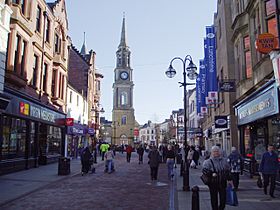 Falkirk High Street |
|
| Area | 11 km2 (4.2 sq mi) |
| Population | 35,590 (2020) |
| • Density | 3,197/km2 (8,280/sq mi) |
| Settled | 7th century |
| Burgh Charter | 1600 |
| Elevation | 37 m (121 ft) |
| OS grid reference | NS887801 |
| Civil parish |
|
| Council area | |
| Lieutenancy area |
|
| Country | Scotland |
| Sovereign state | United Kingdom |
| Post town | FALKIRK |
| Postcode district | FK1, FK2 |
| Dialling code | 01324 |
| Police | Central Scotland |
| Fire | Central Scotland |
| Ambulance | Scottish |
| EU Parliament | Scotland |
| UK Parliament |
|
| Scottish Parliament |
|
Falkirk is a town in the Central Lowlands of Scotland. It's located in the Forth Valley, about 23.5 miles (38 km) northwest of Edinburgh. It's also 20.5 miles (33 km) northeast of Glasgow.
In 2001, Falkirk had a population of 32,422 people. By 2008, this number grew to 34,570. This makes it the 20th largest town in Scotland. Falkirk is the main town and administrative center for the Falkirk council area. This larger area has about 156,800 people. It includes nearby towns like Grangemouth, Bo'ness, Denny, and Larbert.
The town is where the Forth and Clyde and Union Canals meet. This spot was very important for its growth during the Industrial Revolution. In the 1700s and 1800s, Falkirk was a big center for making iron and steel. The Carron Company nearby made many things. These included kitchen items, fireplaces, and even cannons for the Royal Navy. Today, heavy industry is less common. The town's economy now focuses more on shops and tourism. Still, Falkirk is home to big companies like Alexander Dennis. This is the largest bus production company in the UK. Falkirk also has a long history with publishing. The company Johnston Press started here in 1846. It still publishes the Falkirk Herald newspaper.
Some popular places to visit in Falkirk are the Falkirk Wheel, The Helix, The Kelpies, and Callendar House and Park. You can also see parts of the old Antonine Wall. In 2011, a poll by STV named Falkirk Scotland's most beautiful town.
Contents
- Falkirk's Past: A Look Back in Time
- Falkirk's Landscape and Weather
- People and Economy of Falkirk
- Culture and Fun in Falkirk
- Famous Landmarks of Falkirk
- Getting Around Falkirk
- Learning in Falkirk
- Media and Religion in Falkirk
- Sports in Falkirk
- Falkirk's Twin Towns
- Famous People from Falkirk
- Images for kids
- See also
Falkirk's Past: A Look Back in Time

The name An Eaglais Bhreac means "speckled church" in Scottish Gaelic. This likely refers to a church built with different colored stones. The Scots language later called it Fawkirk, meaning "variegated church". This then became the modern English name, Falkirk. The Falkirk Old Parish Church stands where a very old church might have been built around the 7th century.
The Antonine Wall runs right through the middle of Scotland. Parts of it can still be seen in Callendar Park. This wall was built by the Romans around 140 AD. It was the northern border of the Roman Empire. Unlike Hadrian's Wall, it was made of turf, so less of it remains today. Many Roman items have been found in Falkirk. These include Roman coins and a piece of tartan cloth. This tartan is thought to be the oldest ever found! A Roman fort was also discovered in the Pleasance area in 1991.
In the 1700s, Falkirk became a key place for Scotland's Industrial Revolution. It was one of the first big centers for making iron. James Watt, who invented the steam engine, even had parts for his engines made at the Carron Iron Works in 1765. The area was also important for building canals. The Forth and Clyde Canal opened in 1790. The Union Canal (1822) connected Falkirk to Edinburgh. Early railways also came in the 1830s and 1840s. These canals and railways brought a lot of money and growth to Falkirk. Many companies started here because of this expansion. Falkirk even became the first town in Great Britain to have automated street lighting.
Famous Battles of Falkirk
Two very important battles happened in Falkirk's history:
- The Battle of Falkirk took place on July 22, 1298. In this battle, William Wallace was defeated by King Edward I of England.
- The Battle of Falkirk Muir happened on January 17, 1746. Here, the Jacobites, led by Charles Edward Stuart, beat a government army.
Falkirk's Landscape and Weather
Falkirk is located in an area with rolling hills. It sits between 164 feet (50 meters) and 410 feet (125 meters) above sea level. The River Carron flows north of the town. Two smaller streams, the East Burn and West Burn, also run through Falkirk.
The land under Falkirk was shaped by glaciers. Higher areas have a mix of glacial till and clay. Lower areas have sandy soils. Because Falkirk is close to the coast, you can see features like old raised beaches. These create different heights within the town.
 |
Stirling | Stenhousemuir | Grangemouth, Dunfermline |  |
| Denny | Linlithgow | |||
| Cumbernauld, Glasgow | Slamannan | Livingston, Bathgate |
Falkirk's Climate
Falkirk has a mild temperate maritime climate. This means it's not too hot or too cold, even though it's quite far north. Winters are mild, with temperatures rarely dropping below 0°C (32°F). Summers are cooler, usually not going above 23°C (73°F). Being near the sea helps keep the temperatures steady.
The wind usually comes from the southwest. This brings warm, moist air and often rain. Winds from the east are usually drier but colder. Rain falls fairly evenly throughout the year. Strong Atlantic storms can affect the town from October to March. The highest temperature ever recorded was 31.5°C (88.7°F) in August 2010.
| Climate data for Falkirk (1991–2020) | |||||||||||||
|---|---|---|---|---|---|---|---|---|---|---|---|---|---|
| Month | Jan | Feb | Mar | Apr | May | Jun | Jul | Aug | Sep | Oct | Nov | Dec | Year |
| Mean daily maximum °C (°F) | 7.3 (45.1) |
8.0 (46.4) |
9.9 (49.8) |
12.6 (54.7) |
15.7 (60.3) |
18.0 (64.4) |
19.8 (67.6) |
19.6 (67.3) |
17.2 (63.0) |
13.4 (56.1) |
9.9 (49.8) |
7.4 (45.3) |
13.2 (55.8) |
| Mean daily minimum °C (°F) | 1.2 (34.2) |
1.5 (34.7) |
2.5 (36.5) |
4.2 (39.6) |
6.6 (43.9) |
9.7 (49.5) |
11.3 (52.3) |
11.1 (52.0) |
9.1 (48.4) |
5.9 (42.6) |
3.2 (37.8) |
1.1 (34.0) |
5.6 (42.1) |
| Average rainfall mm (inches) | 111.8 (4.40) |
93.0 (3.66) |
72.6 (2.86) |
46.3 (1.82) |
53.5 (2.11) |
69.2 (2.72) |
74.6 (2.94) |
78.2 (3.08) |
70.1 (2.76) |
99.0 (3.90) |
97.0 (3.82) |
106.2 (4.18) |
971.7 (38.26) |
| Average rainy days (≥ 1 mm) | 15.3 | 12.8 | 12.3 | 9.8 | 11.0 | 11.4 | 12.6 | 12.6 | 12.0 | 14.1 | 15.2 | 14.8 | 154.0 |
| Mean monthly sunshine hours | 40.1 | 71.7 | 100.7 | 136.3 | 172.2 | 147.3 | 149.6 | 141.5 | 111.8 | 80.7 | 52.4 | 33.6 | 1,237.9 |
| Source: Met Office | |||||||||||||
People and Economy of Falkirk
In 2001, Falkirk had 32,422 residents. By 2008, this number grew to 34,570. This makes it the 20th largest town in Scotland. The wider Falkirk area, including places like Grangemouth and Larbert, has about 98,940 people. This makes it the 5th largest urban area in Scotland. The population is expected to grow, partly because people are moving here from other parts of Scotland and the UK. Unemployment in Falkirk is low, at 2.5%, which is below the Scottish average.
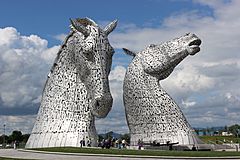
Today, Falkirk's economy is mostly about shops and services. This is different from its past, when it was known for heavy industries. Falkirk is a big shopping center for the town and the surrounding areas. The Howgate Shopping Centre opened in 1990. Many supermarkets like Tesco and Asda have also opened around the town center.
Public services are also a big part of Falkirk's economy. Falkirk Council is one of the largest employers, with over 7,000 workers. The UK Child Support Agency has an office here. The National Health Service (NHS) and Department for Work and Pensions also employ people in the town.
Many Falkirk residents also work in the petrochemicals industry in nearby Grangemouth. This area has many industries related to oil and chemicals, including the Ineos oil refinery. Alexander Dennis, a large bus manufacturer, has its main office in Falkirk.
Culture and Fun in Falkirk
Falkirk used to host a big arts festival called Big in Falkirk. It ran from 2000 to 2009 in Callendar Park. This free festival was one of Scotland's largest cultural events, attracting over 100,000 people. It featured outdoor theater, fireworks, art, comedy, and music.
Falkirk also hosted the Royal National Mòd in 2008. This is a major festival of Scottish Gaelic culture. Since then, interest in Gaelic has grown in Falkirk. There are now five Gaelic groups in the area. These groups offer Gaelic lessons and promote the language.
Things to Do in Falkirk
The historic Callendar House is a large mansion with a 600-year history. It is now a public museum and park. It has a cafe and a shop. The Park Gallery, an art gallery, is also inside the house.
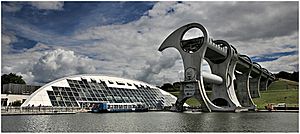
Famous Landmarks of Falkirk
The Falkirk Wheel is a unique rotating boat lift. It's the only one of its kind in the world! It was finished in 2002. It connects the Forth and Clyde Canal to the Union Canal.
On Falkirk High Street, you'll find the Falkirk Steeple. This building was built in 1814. It's a very important historical building. A picture of the Steeple is on the badge of Falkirk Football Club. It's seen as the center of the town.
The FTH Theatre (Falkirk Town Hall Theatre) is on West Bridge Street. It was built to replace an older town hall. In 2022, it was announced that the theatre would close for major renovations. Plans are now in place to build a new town hall, theatre, library, and civic space. It will be built where the old Callendar Square shopping center used to be.
Next to the M9 motorway, between Falkirk and Grangemouth, are The Kelpies. These are 30-meter (98-foot) tall horse-head sculptures. They show kelpies, which are shape-shifting water spirits from Scottish myths. They are part of Helix Park. This project aims to improve connections between communities in Falkirk.
Getting Around Falkirk
Roads in Falkirk
Falkirk is in a central spot in Scotland. It has easy access to major motorways. The M9 connects it to the north and east. The M876 connects it to the west. Falkirk is also close to both Glasgow and Edinburgh airports.
Trains in Falkirk
Falkirk has two train stations: Falkirk High and Falkirk Grahamston.
Falkirk High is on the main line between Glasgow and Edinburgh. Trains run every 15 minutes to both cities. It takes about 24 to 35 minutes to get to Edinburgh. It takes 18 to 28 minutes to get to Glasgow.
Falkirk Grahamston is on the line to Dunblane and Edinburgh. There are 4 trains per hour to Edinburgh. The journey takes about 34 minutes. There are also 2 trains per hour to Glasgow. This journey takes about 39 to 43 minutes.
Buses in Falkirk
The Falkirk bus station used to be in the town center. It closed on August 20, 2018. Now, bus routes have moved to Newmarket Street. These buses connect Falkirk to Stirling, Edinburgh, and Glasgow, as well as local areas.
Learning in Falkirk
Falkirk is home to one of the four campuses of Forth Valley College. This college was formed in 2005 by combining three local colleges. The Falkirk Campus is the largest of the four.
High Schools in Falkirk
The Falkirk area has eight high schools. All of them have been rebuilt recently.
| School | Students | Opened | Primary Schools that feed into it |
| Bo'ness Academy | Originally 1931, rebuilt 2000 | Blackness, Bo'ness Public, Deanburn, Grange, and Kinneil Primary Schools | |
| Braes High School | 2000 | Avonbridge, California, Drumbowie, Maddiston, Shieldhill and Wallacestone Primary Schools | |
| Denny High School | Originally 1959 | Denny, Nethermains, Dunipace, Head of Muir, Bankier and Bonnybridge Primary Schools | |
| Falkirk High School | 1,200 | Originally 1886, rebuilt 2010 | Bainsford, Bantaskin, Carmuirs, Comely Park, Easter Carmuirs, Langlees, Limerigg and Slamannan Primary Schools |
| Graeme High School | 1,200 | Originally 1930, rebuilt 2000 | Hallglen, Laurieston, St. Margaret's, Victoria, Westquarter and Whitecross Primary Schools |
| Grangemouth High School | 810 | rebuilt 2009 | Bowhouse, Beancross, and Moray Primary Schools |
| Larbert High School | 1,700 | Originally 1885, rebuilt 2000 | Airth, Bothkennar, Carron, Carronshore, Kinnaird, Ladeside, Larbert Village and Stenhousemuir Primary Schools |
| St. Mungo's High School | 1,200 | Originally 1953, rebuilt 2009 | Falkirk area |
Media and Religion in Falkirk
Falkirk has a weekly newspaper called the Falkirk Herald. It is published by Johnston Press. This company was started by the Johnston family from Falkirk in 1767. They bought the Herald in 1846. The company's main office is now in Edinburgh, but it still has offices in Falkirk and Grangemouth.
In the 2001 census, most people in Falkirk said they were Christian. About 48% belonged to the Church of Scotland. 12% were Roman Catholic. 5% belonged to other Christian groups. 29% of people said they had no religion.
Sports in Falkirk
Football
Men's Football Teams
Falkirk has three men's football teams: Falkirk Football Club, Stenhousemuir F.C., and East Stirlingshire Football Club.
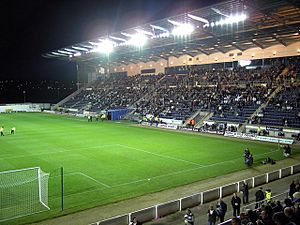
Falkirk F.C. started in 1876. They joined the Scottish Football League in 1902. Their best results were finishing second in Scotland's top league in 1907–08 and 1909–10. They have reached the Scottish Cup final five times, winning twice in 1913 and 1957. The club now plays in the Scottish Championship. Their home games are at the Falkirk Stadium.
East Stirlingshire F.C. started in 1881. They have been in the Scottish Football League since 1900. They have mostly played in the lower leagues. They currently play in the Lowland Football League. From 2018–19, they also play their home games at the Falkirk Stadium.
Women's Football Teams
Falkirk has two women's football teams: Central Girls Football Academy and Falkirk Ladies. Central plays in the second tier of women's football (SWPL2). Falkirk plays in the third tier (SWFL).
Roller Derby
Falkirk is home to Scotland's first co-ed roller derby league. The teams are the Skelpies (men's), the Central Belters (women's), and the Belter Skelpers (co-ed).
Rugby
Falkirk Rugby Club started in 1906. It was restarted in 1972. The club has moved up through the rugby leagues. They won six promotions in a row, which is a Scottish record!
Hockey
Falkirk also has a Hockey team, Falkirk GHG Hockey Club. It was formed in 1999. They have four men's teams. Their top team plays in the national league.
Basketball
Falkirk Fury Basketball Club, also known as Clark Eriksson Fury Basketball Club, represents the town. The team started in 1992. They now compete in all 6 Scottish National Age Groups. The men's team plays in the Scottish Men's National League. This is the top league in Scottish basketball. The club plays home games at the Mariner Centre in Camelon.
Archery
Falkirk has several archery clubs. The Falkirk Company of Archers started in 1971. They shoot outdoors in summer and indoors in winter. Most members use recurve bows, but some also use traditional bows like longbows.
Falkirk's Twin Towns
Falkirk is connected to other towns around the world. These are called twin towns:
- Créteil, France
- Odenwald, Germany
- Quimper, France
- San Rafael, California, United States
Famous People from Falkirk
Art and Writing
- Alan Bissett - a Scottish writer
- Dame Elizabeth Blackadder - artist
- Alan Davie - artist (born in Grangemouth)
- Janet Paisley - poet and writer
- Stuart Reid - children's book author
Business and Industry
- Walter Alexander - started Walter Alexander Coachbuilders in Falkirk. This became one of the world's largest bus builders.
- Robert Barr - founded Barr's, the company that makes Irn-Bru.
- Captain Robert Dollar - a Scottish-American businessman, born in Falkirk.
- William Forbes of Callendar - owned the Carron Iron Works.
Media and Entertainment
- Kaye Adams - Television presenter
- Ruth Connell - Actress and producer
- Elizabeth Fraser - Singer from the band Cocteau Twins
- Robin Guthrie - Guitarist from the band Cocteau Twins
- Brian McNeill - Scottish folk singer
- Forbes Masson - Actor and writer
- Malcolm Middleton, David Gow and Aidan Moffat - from the band Arab Strap
- Euan Morton - Actor and singer, known for playing Boy George in the musical Taboo
- David Paisley - Actor and singer
Science and Technology
- John Aitken - physicist and meteorologist. He invented the koniscope to detect dust particles.
- George Forrest - a Scottish botanist. He brought back many plant specimens from China.
- Alfred Nobel - the inventor of dynamite, lived in Falkirk for several years.
Sports and Recreation
- Nicola Docherty - Footballer for Rangers W.F.C. and Scotland.
- Steve Frew - Won Scotland's first Gymnastics Gold Medal at the Commonwealth Games.
- Bob McGregor - Swimmer who won a silver medal at the 1964 Olympic Games.
- Willie Ormond - Former footballer for Hibs and Scotland.
- David Provan - Former footballer for Rangers.
- Leanne Ross - Footballer for Glasgow City F.C. and Scotland.
- Alex Scott - Former footballer for Rangers and Everton.
- Eddie Turnbull - Former footballer for Hibs and Scotland.
- David Weir - Former footballer.
Images for kids
See also
 In Spanish: Falkirk para niños
In Spanish: Falkirk para niños


